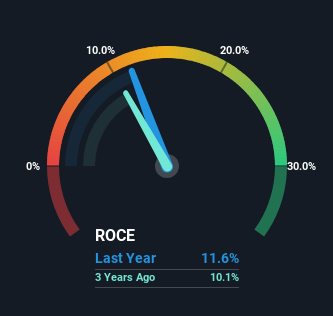What trends should we look for it we want to identify stocks that can multiply in value over the long term? Typically, we'll want to notice a trend of growing return on capital employed (ROCE) and alongside that, an expanding base of capital employed. Ultimately, this demonstrates that it's a business that is reinvesting profits at increasing rates of return. With that in mind, the ROCE of Servotech Power Systems (NSE:SERVOTECH) looks decent, right now, so lets see what the trend of returns can tell us.
Understanding Return On Capital Employed (ROCE)
If you haven't worked with ROCE before, it measures the 'return' (pre-tax profit) a company generates from capital employed in its business. The formula for this calculation on Servotech Power Systems is:
Return on Capital Employed = Earnings Before Interest and Tax (EBIT) ÷ (Total Assets - Current Liabilities)
0.12 = ₹189m ÷ (₹2.8b - ₹1.1b) (Based on the trailing twelve months to June 2024).
So, Servotech Power Systems has an ROCE of 12%. In absolute terms, that's a pretty standard return but compared to the Electrical industry average it falls behind.
See our latest analysis for Servotech Power Systems

Historical performance is a great place to start when researching a stock so above you can see the gauge for Servotech Power Systems' ROCE against it's prior returns. If you're interested in investigating Servotech Power Systems' past further, check out this free graph covering Servotech Power Systems' past earnings, revenue and cash flow.
What Can We Tell From Servotech Power Systems' ROCE Trend?
The trend of ROCE doesn't stand out much, but returns on a whole are decent. The company has employed 255% more capital in the last five years, and the returns on that capital have remained stable at 12%. Since 12% is a moderate ROCE though, it's good to see a business can continue to reinvest at these decent rates of return. Stable returns in this ballpark can be unexciting, but if they can be maintained over the long run, they often provide nice rewards to shareholders.
On a separate but related note, it's important to know that Servotech Power Systems has a current liabilities to total assets ratio of 41%, which we'd consider pretty high. This can bring about some risks because the company is basically operating with a rather large reliance on its suppliers or other sorts of short-term creditors. While it's not necessarily a bad thing, it can be beneficial if this ratio is lower.
The Bottom Line
The main thing to remember is that Servotech Power Systems has proven its ability to continually reinvest at respectable rates of return. And the stock has done incredibly well with a 16,805% return over the last five years, so long term investors are no doubt ecstatic with that result. So while the positive underlying trends may be accounted for by investors, we still think this stock is worth looking into further.
One more thing, we've spotted 3 warning signs facing Servotech Power Systems that you might find interesting.
If you want to search for solid companies with great earnings, check out this free list of companies with good balance sheets and impressive returns on equity.
New: Manage All Your Stock Portfolios in One Place
We've created the ultimate portfolio companion for stock investors, and it's free.
• Connect an unlimited number of Portfolios and see your total in one currency
• Be alerted to new Warning Signs or Risks via email or mobile
• Track the Fair Value of your stocks
Have feedback on this article? Concerned about the content? Get in touch with us directly. Alternatively, email editorial-team (at) simplywallst.com.
This article by Simply Wall St is general in nature. We provide commentary based on historical data and analyst forecasts only using an unbiased methodology and our articles are not intended to be financial advice. It does not constitute a recommendation to buy or sell any stock, and does not take account of your objectives, or your financial situation. We aim to bring you long-term focused analysis driven by fundamental data. Note that our analysis may not factor in the latest price-sensitive company announcements or qualitative material. Simply Wall St has no position in any stocks mentioned.
About NSEI:SERVOTECH
Servotech Renewable Power System
Manufactures and sells light-emitting diode (LED) lights, electric vehicle (EV) chargers, and solar power products in India and internationally.
Excellent balance sheet with poor track record.
Similar Companies
Market Insights
Community Narratives



